features
How to cook with rhubarb – a Twisted guide
03 Mar 2023
13m
Rhubarb is everywhere ATM, but how do you cook it, how do you grow it and is it a fruit or vegetable?
It gets a bit of a bad rap today – often seen by naysayers as old fashioned or just a bit unglamorous – but that’s just because a lot of us are clueless about what to do with it, and what on earth it even is…
Keen to redeem its image, we’ve compiled a guide to prepping, cooking and eating the seasonal ingredient. Because, trust us, once you’re a rhubarb expert we’re confident you’ll never look back.
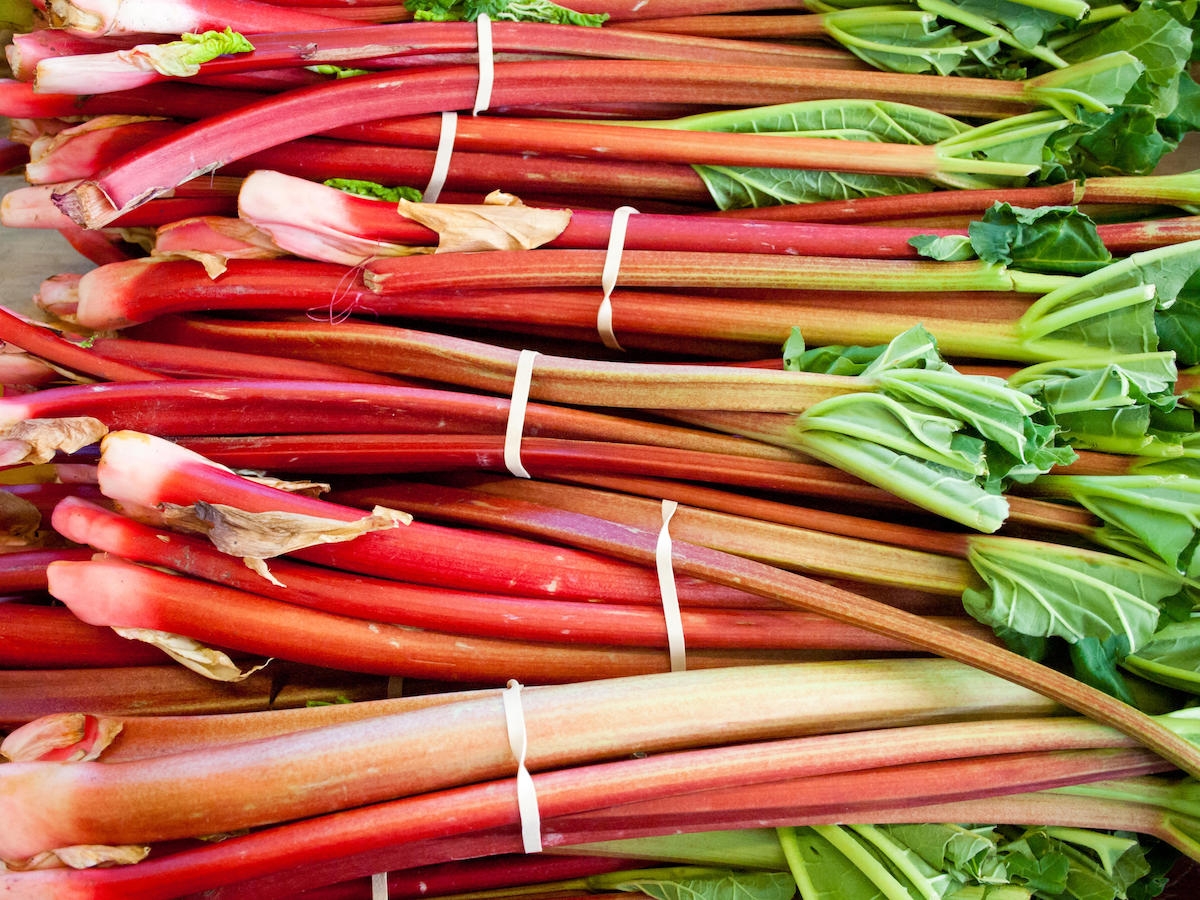
Rhubarb is back for spring (Credit: Rhubarb)
READ MORE: How to prep, cook and eat Wild Garlic
What is rhubarb?
Rhubarb is a perennial plant that belongs to the dock family. With large green leaves and a bright pink or red stalk, the rhubarb kinda gives off the aesthetic of a celery with blusher on, but believe it or not, the two are of no relation.
You’ve likely see ingredient in a lot of British cooking, from rhubarb crumbles to brightly coloured tarts, but in actual fact it isn’t thought to have originated in the UK.
Whilst its exact origin isn’t known, experts have traced it back to China in 2700BC, where it’s said to have been hailed for its health benefits and used medicinally (more on that later).
Then, in the thirteenth century it made it over to Europe – although it wasn’t until the nineteenth century that people started using it in their cooking.
Today, rhubarb thrives in countries with cool climates, and is commonly grown in the UK and the US, as well as places like Australia and New Zealand.
It can be enjoyed both savoury and sweet, and whilst it doesn’t always have the sexiest reputation, it’s actually incredibly versatile and delicious when cooked right.
What does rhubarb taste like?
Rhubarb can taste very tart and even sour, so it’s unsurprising that some people might turn their noses up at it.
You could compare the taste of rhubarb to that of a citrus fruit or an unripened green apple, but as with many ingredients, it’s all in how you prep, cook and eat it in order to bring its best attributes.
For one, when you cook rhubarb it loses its crunch and softens, whilst also mellowing in flavour.
The reason it’s so popular in desserts is because its tartness actually works very well when offset with sweeter flavour notes.
However, when balanced correctly, it also adds a nice, fresh tang to savoury stews, salsas and salads.
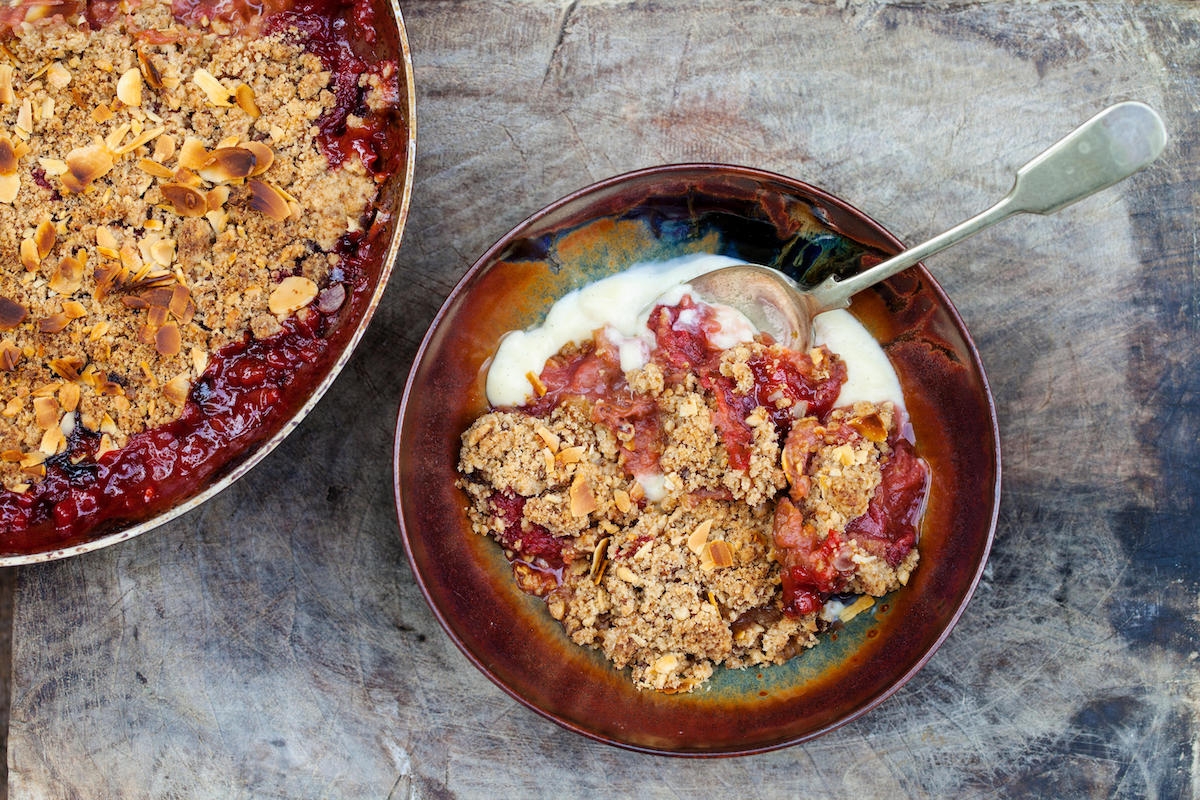
You’ve probably had a rhubarb crumble before (Credit: Alamy)
Is rhubarb a fruit or vegetable?
We know that vegetables are officially identified because they have leaves, stalks and roots, whilst fruit are identified because they have seeds. It’s for this reason that we know for sure rhubarb is a veggie.
However, despite being botanically a vegetable, it’s understandable why some people might mistake it for a fruit.
For one, there’s no ignoring the fact that most of the more popular rhubarb recipes treat it in the same way you would a fruit – cooking it down with sugar.
This became so obvious in 1947 that the U.S. Customs Court legally classed rhubarb as a fruit (they said it wouldn’t be fair for people to have to pay higher taxes, as they did with vegetables, given its uses).
Basically, if you did think rhubarb was a fruit, you’re not wrong on a technicality – even though it is a vegetable by definition.
READ MORE: Twisted chats to Yotam Ottolenghi about fusion food
When is rhubarb in season?
Garden and field grown rhubarb is a surefire sign of spring, coming into season from April and sometimes remaining available until September here in the UK.
The National Trust says that the US also sees rhubarb emerging at the start of spring, and in both continents you’ll come across farmers markets and restaurant menus dotted with the stuff as the seasons change.
There are lots of varieties of rhubarb, and they all emerge at slightly different times, look different and have slightly varied flavour profiles.
Timperley Early, Valentine and Victoria are all common types, but you can find a more extensive list here, if you’re interested.
As the name suggests, Timperley Early sprouts at the start of the season in early April, and is one of the first varieties of rhubarb to exist. This one is sweet and tends to have a longer, thinner stalk.
The Valentine variety has greener stalks and is also one of the sweeter types of rhubarb which starts to show its face in April, whilst the later emerging Victoria rhubarb tend to be larger, with greeny-pink stems and a more robust balance of sweetness and acidity.
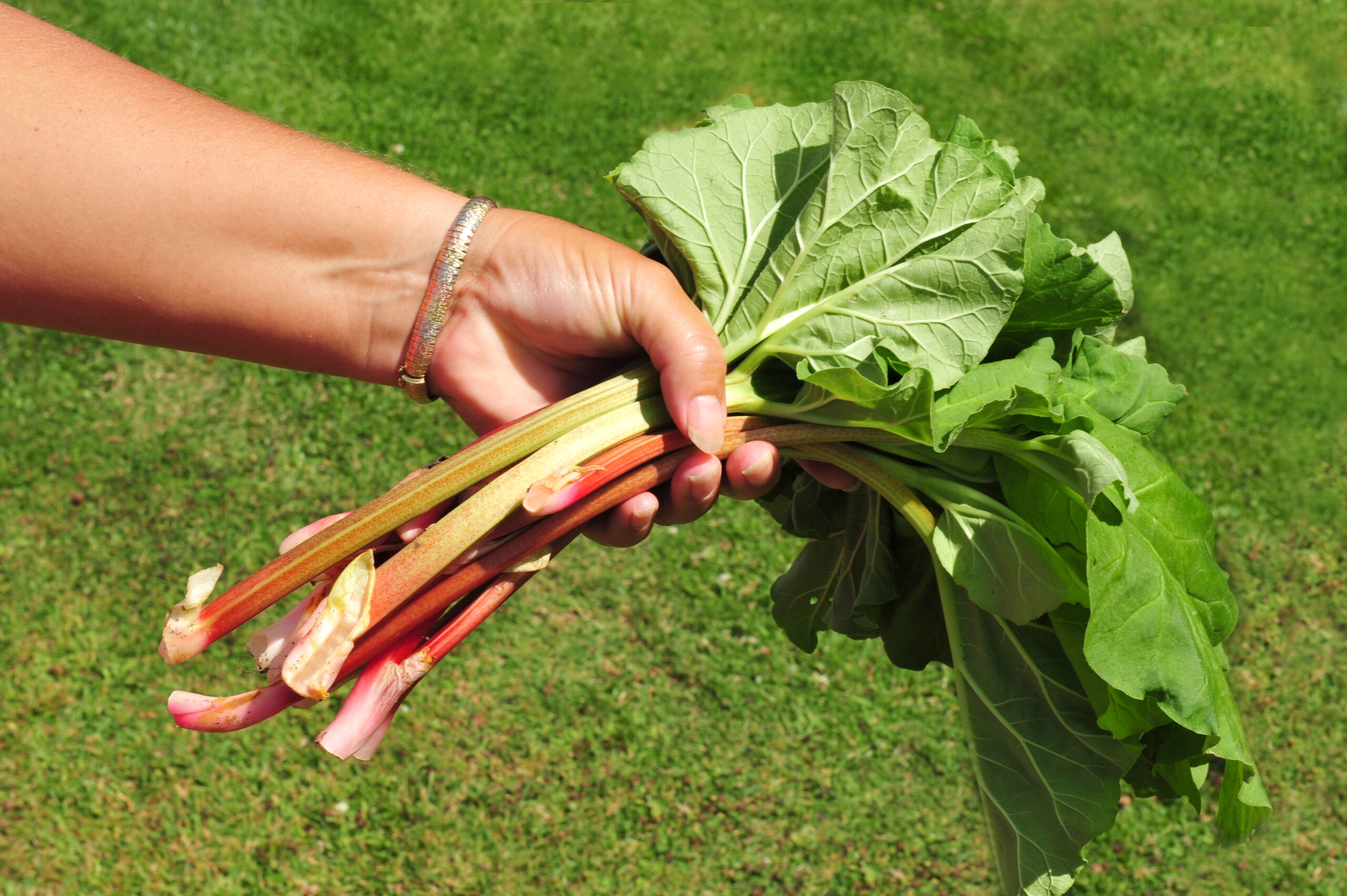
There are loads of varieties of rhubarb today (Credit: Alamy)
What is forced rhubarb?
Forced rhubarb is when rhubarb is encouraged to grow off-season.
Unlike the garden and field rhubarb, it’s grown in dark ‘forcing sheds,’ and can be harvested by candle light from Christmas up until the start of spring.
“Forcing rhubarb in late winter will provide an early harvest at the beginning of spring, giving you plenty of tender stems to make into crumbles and cordials,” confirms The English Garden magazine.
The technique was actually born in the early nineteenth century in London’s Chelsea, and is particularly prominent in Yorkshire today.
“Forcing involves preventing light from reaching the crowns of the rhubarb plants,” the publication goes on. “This triggers the production of delicious pale stalks perfect for cooking.”
Gardeners that don’t have forcing sheds even just use a pot to cover the crown of the rhubarb, shutting out light and encouraging the same process.
The end result is tender and often more sweet than your traditional rhubarb – although the flavour is usually less bold and punchy.

Forced rhubarb grows in dark sheds (Credit: Alamy)
READ MORE: Top chefs on how to ‘vegan-ify’ popular dishes
What is The Rhubarb Triangle?
The Rhubarb Triangle is the name given to a nine square mile area of West Yorkshire, where Leeds, Wakefield and Bradford meet.
What’s it got to do with rhubarb? You might ask…Well, the climate and the soil in this area makes it a pretty dreamy spot to grow the ingredient, and this, paired with the transport links to London, prompted the commercial growth of the vegetable back in the late 1800s.
It all begun in 1877, and at the start of the 20th century, when the Whitcliffe family of Leeds heard of a London forcing shed and started up their own.
In its height, the Yorkshire rhubarb trade was so successful that there was even a train called ‘The Rhubarb Express’ which transported the supplies to the Capital during rhubarb season.
Today, The Rhubarb Triangle is still the area that most of the UK’s rhubarb is grown.
The vegetable is initially grown outside for two years, and then it is brought into forcing sheds and left in darkness, to bring out the plant’s hardy stems.
So important is The Rhubarb Triangle as a supplier of the country’s rhubarb that it was given Protected Designation of Origin (PDO) back in 2010. Fancy that!
What does rhubarb go with?
Rhubarb is all about what you pair it with, and given its distinctive flavour it’s really important you serve it with flavours that compliment it.
The vegetable’s tart, bitter taste means it often needs another ingredient to balance it out, but this is where the opportunity for creativity begins.
Here are 12 of our favourite ingredients to pair rhubarb with, to whet your appetite:
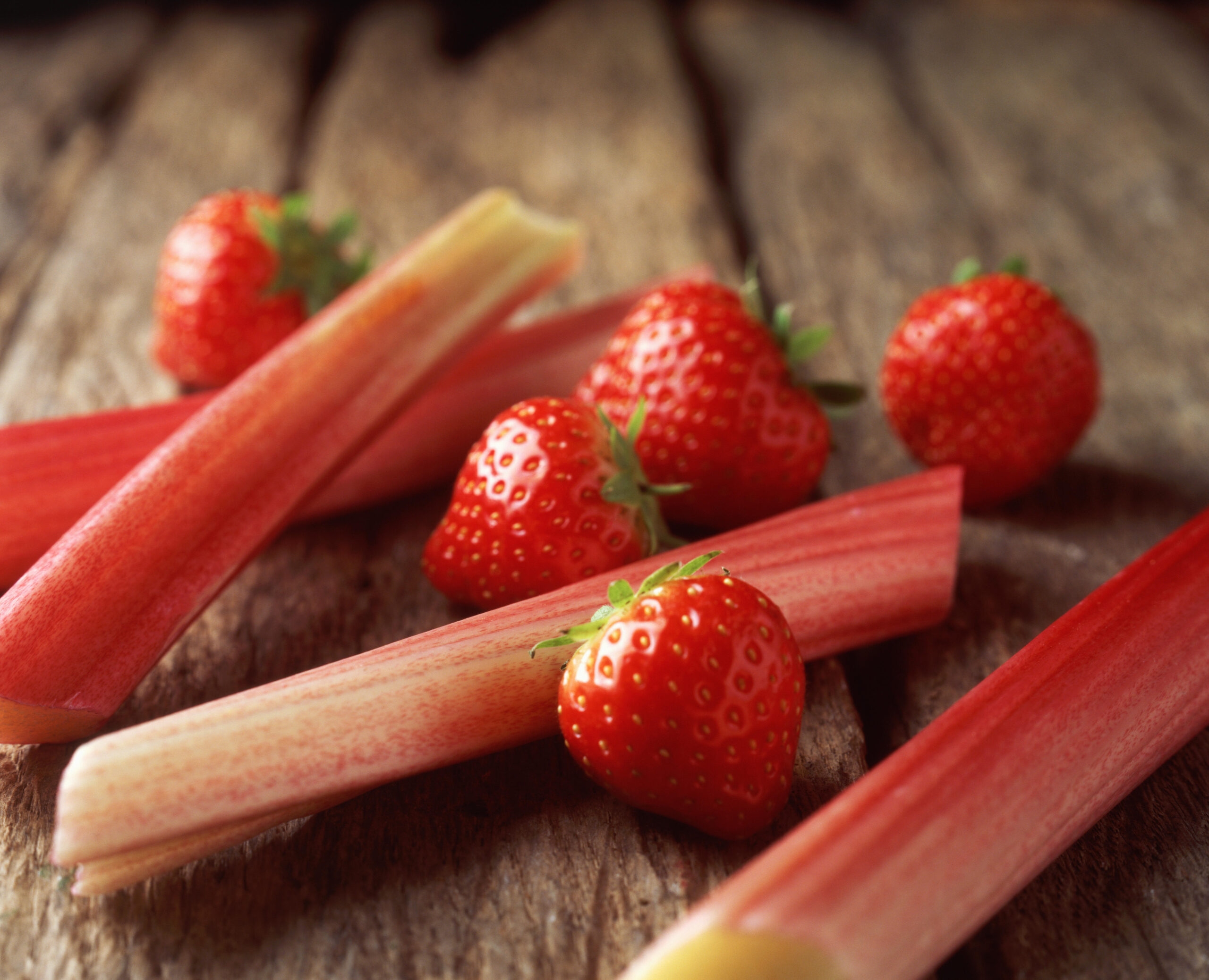
Rhubarb an any sweet berry is a dream combo (Credit: Alamy)
- Strawberries – these add a sweet, fragrant contrast to the tart flavour of the rhubarb.
- Vanilla – another sweet ingredient that tempers rhubarb’s bitterness and makes it taste a little more delicate.
- Lavender – floral notes of lavender help to mellow and refine the punchy rhubarb flavours.
- Lemon – lemon and rhubarb might seem too sour a combo, but in actual fact it further brings out this citrusy flavours of the vegetable when it’s cooked, especially when paired with sugar in a dessert.
- Ginger – both fresh and ground ginger add a warmth and spiciness that calms rhubarb’s tangy urges in either sweet or savoury dishes.
- Pineapple – pineapple and rhubarb compliment each other nicely, offering the perfect ratio of sweetness, fruitiness and earthy bitterness.
- Cream – a rich, dairy cream takes away some of rhubarb’s bite and works particularly well with the vegetable when it’s stewed.
- Orange – rhubarb and orange is a fresh and zesty combination, with fruit naturally sweetening the rhubarb whilst coaxing out those citrus notes.
- Custard – as you see with retro sweets, the sweet, tart and creamy flavours of custard and rhubarb keep each other at bay.
- Pork – rhubarb adds a sharp, fresh element when cooked with rich, roasted pork.
- Poultry – sweet, tangy rhubarb brings out the umami flavours of roasted chicken.
- Tomatoes – sweet tomatoes get an extra boost of acidity when paired with rhubarb in a savoury dish or a chutney.
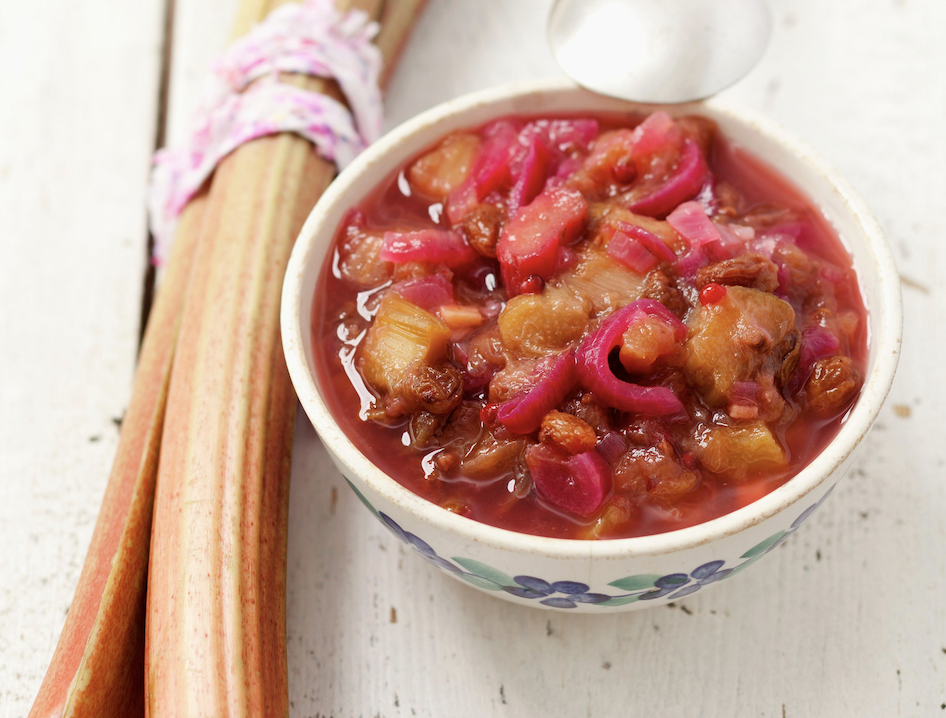
Anyone for rhubarb chutney? (Credit: Alamy)
READ MORE: The best online cooking classes for aspiring master chefs
How to prepare rhubarb
Inspired? Then let’s get cooking. To prepare rhubarb, you first have to remove the leaves so that only the stalks remain (this is a really important step, and we’ll get to why later on).
Then, wash your vegetable, pat it dry and pull away any stringy bits before going any further. There’s no need to peel it – you wanna keep that colour.
The exact method of chopping rhubarb will vary from recipe to recipe, but in most cases you’ll be required to cut it up into baton-style chunks so that they keep their shape when cooked.
After you’ve done your prepping, there are lots of nifty ways you can cook the vegetable, and each bring out different qualities.
How to cook rhubarb
Rhubarb is one of those vegetables you can cook in several different ways, but it’s most commonly stewed.
It can also be roasted oe even poached, and each of these methods bring out a totally different side of the often misunderstood veggie.
Here’s a rundown on the two most common ways to cook rhubarb:
How to stew rhubarb
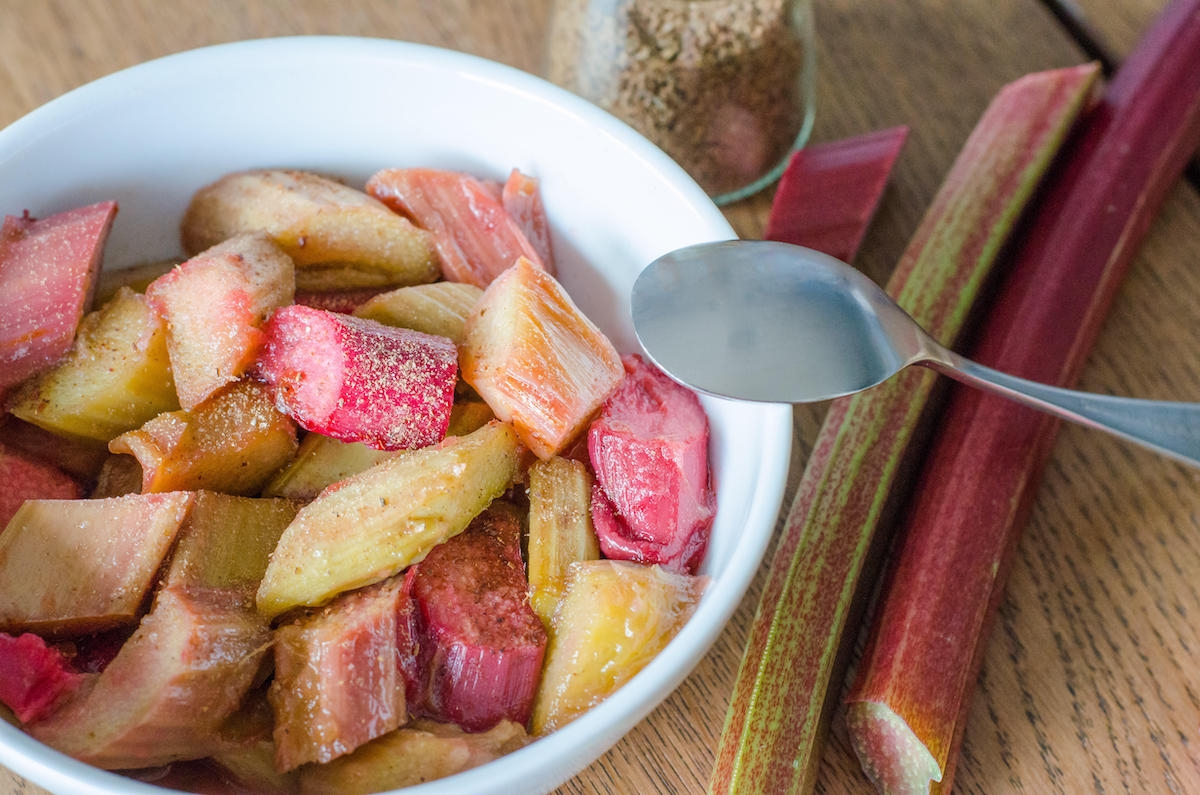
Stewed rhubarb is a very lovely thing (Credit: Alamy)
Stewed rhubarb is a beautiful way to soften the vegetable and bring out a milder flavour from it. You don’t need much water in this process as it’s already very moisture dense.
Stewing is a super easy way to cook rhubarb, and the end result pairs beautifully with ice cream, custard or porridge.
You can stew rhubarb using the following basic recipe:
You’ll Need
- 600g of rhubarb
- 150g sugar
- 2.5 tbs water
- 1 large orange
Method
- Put your chopped rhubarb in a saucepan and add your sugar, the water and the orange juice and zest, bringing everything to the boil.
- Once it’s hot, turn the heat down and allow the rhubarb to simmer.
- The rhubarb should hold its shape but appear soft and tender. Then, it’s ready to serve.
How to roast rhubarb
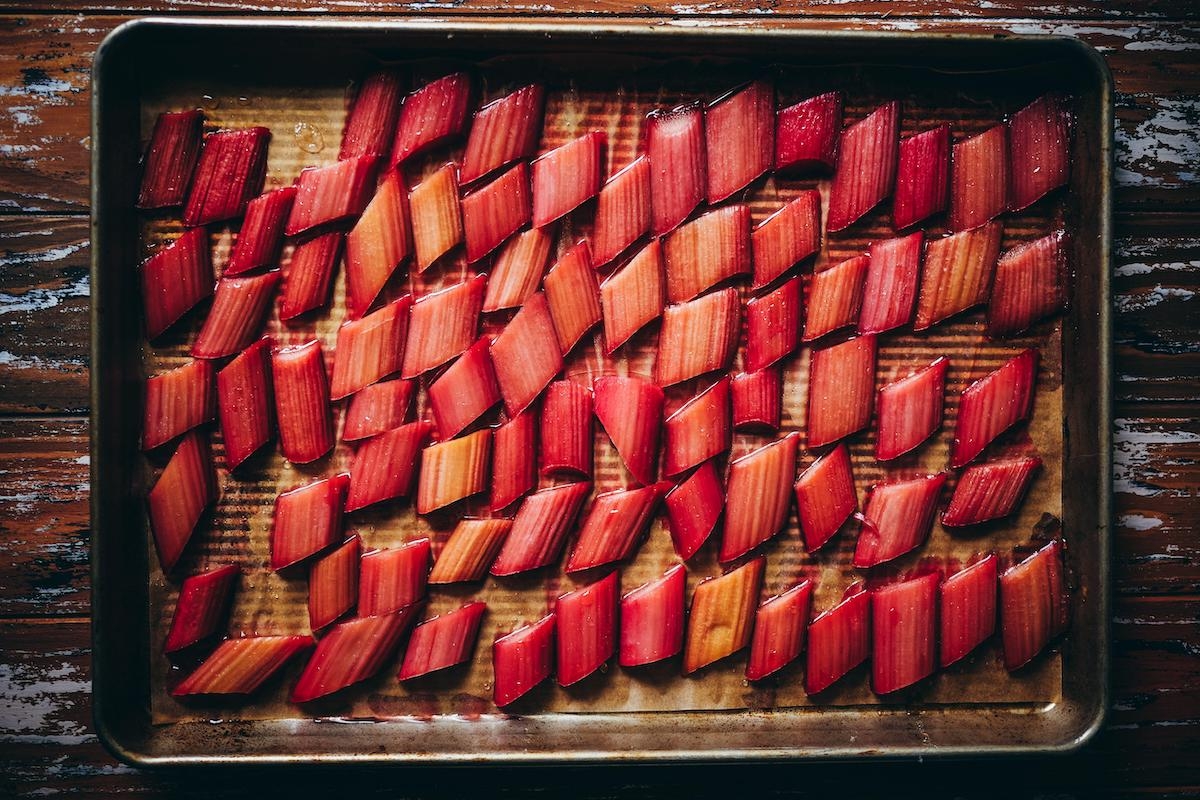
You can roast rhubarb, too (Credit: Alamy)
Roasting rhubarb is a great way to slowly bring out its flavours, ensure it loses any crunch and becomes nice and juicy.
This method allows the vegetable to preserve its bright, eye-catching colour and intensifies its sweetness and fruitiness. It can then be eaten as above with cream or ice cream, popped in a tart or chucked into a salad, if you prefer.
You can roast rhubarb using the following basic recipe:
You’ll Need
- 500g rhubarb
- 150g sugar
Method
- Put chopped rhubarb in a bowl and sprinkle with sugar so it is fully covered.
- Let the sugary rhubarb marinate for at least half an hour (or a couple of hours if you have time)
- Then, pop in the oven and roast for half an hour.
- Let it cool and then serve.
READ MORE: Chef Rachel Ama on the joys of tweaking Caribbean dishes from her youth
Can you eat raw rhubarb?

Some people eat raw rhubarb, too (Credit: Alamy)
You can eat raw rhubarb, too – although this is when it’s at its tartest.
If you go down this route, it’s important to only eat the stalk. Most people dip it in something sweet, like honey, sugar or maple syrup as on its own it isn’t for the feint hearted.
A sour punch of raw rhubarb can also compliment a salad when grated really finely, plus we’d recommend chopping it and adding it to cereal, porridge or a compote.
Raw rhubarb isn’t to everyone’s taste, so you might wanna avoid serving it at your next dinner party. Saying that, it’s great for those of us who can handle a bit of tang.
How to store rhubarb
There are a couple of ways to store rhubarb at home, depending how soon you wanna cook with it.
- Sometimes, it can stay fresh when left at room temperature for a week, but that’ll depend on how fresh it was when you picked it. If you kitchen is humid or warm then that could also impact the amount of time your rhubarb stays at its best.
- Putting your rhubarb in the fridge often ensures it lasts a couple of weeks (and sometimes up to a month). For best results, wrap the stalks loosely in tin foil to stop them drying out.
Can you freeze rhubarb?
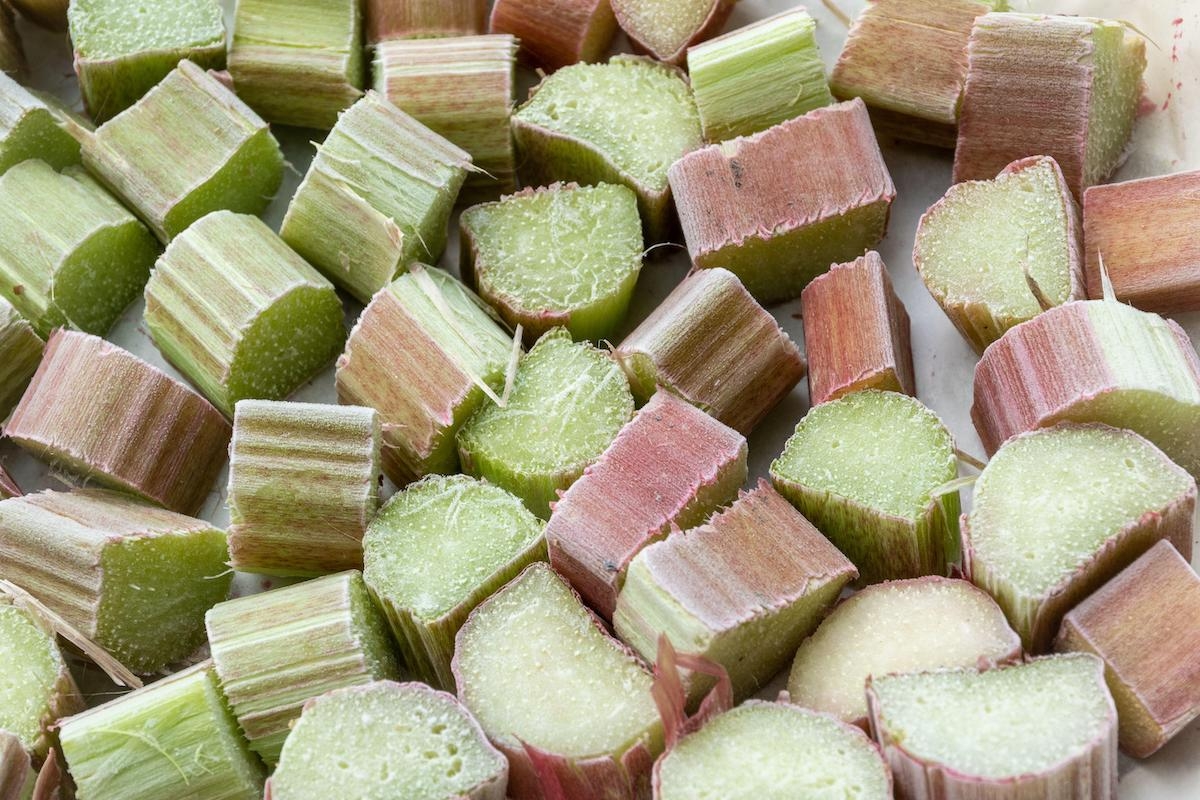
You can pop chunks of rhubarb in the freezer (Credit: Alamy)
Freezing your rhubarb is another great way to ensure you have a supply all year round. In fact, with this method it can last for up to a year.
To do this, follow the below instructions:
- Wash, dry and chop your rhubarb stems and completely remove the leaves.
- Place your rhubarb batons on a baking tray so they are evenly spread and freeze for 2-3 hours until completely solid.
- Then, remove the pieces of rhubarb from the sheet and pop into a freezer bag or Tupperware.
- Put this back in the freezer and it can live there for up to a year.
This method is a pretty great zero waste trick, if you’ve got some rhubarb you’re not gonna use. Plus, it also means you can pluck some rhubarb from your freezer whenever your heart desires. Winner.
READ MORE: Hangin’ With: What do fusion chefs eat on a hangover?
How to grow rhubarb
The Royal Horticultural Society says that rhubarb is “extremely easy to grow,” so if you’re into gardening, why not give it a bash?
You grow rhubarb by planting crowns – which are young rhubarb plants (usually a couple of years old).
The best time to plant it at the end of autumn (so, off season), however, you can also plant your rhubarb early spring.
It’s worth noting that the plant grows year after year, so you’ll want to find a permanent spot for it in your garden, and give it lots of space to make itself a home.
It should ideally be a sunny location with moist, well-drained soil for best results, although it can cope with some shade.
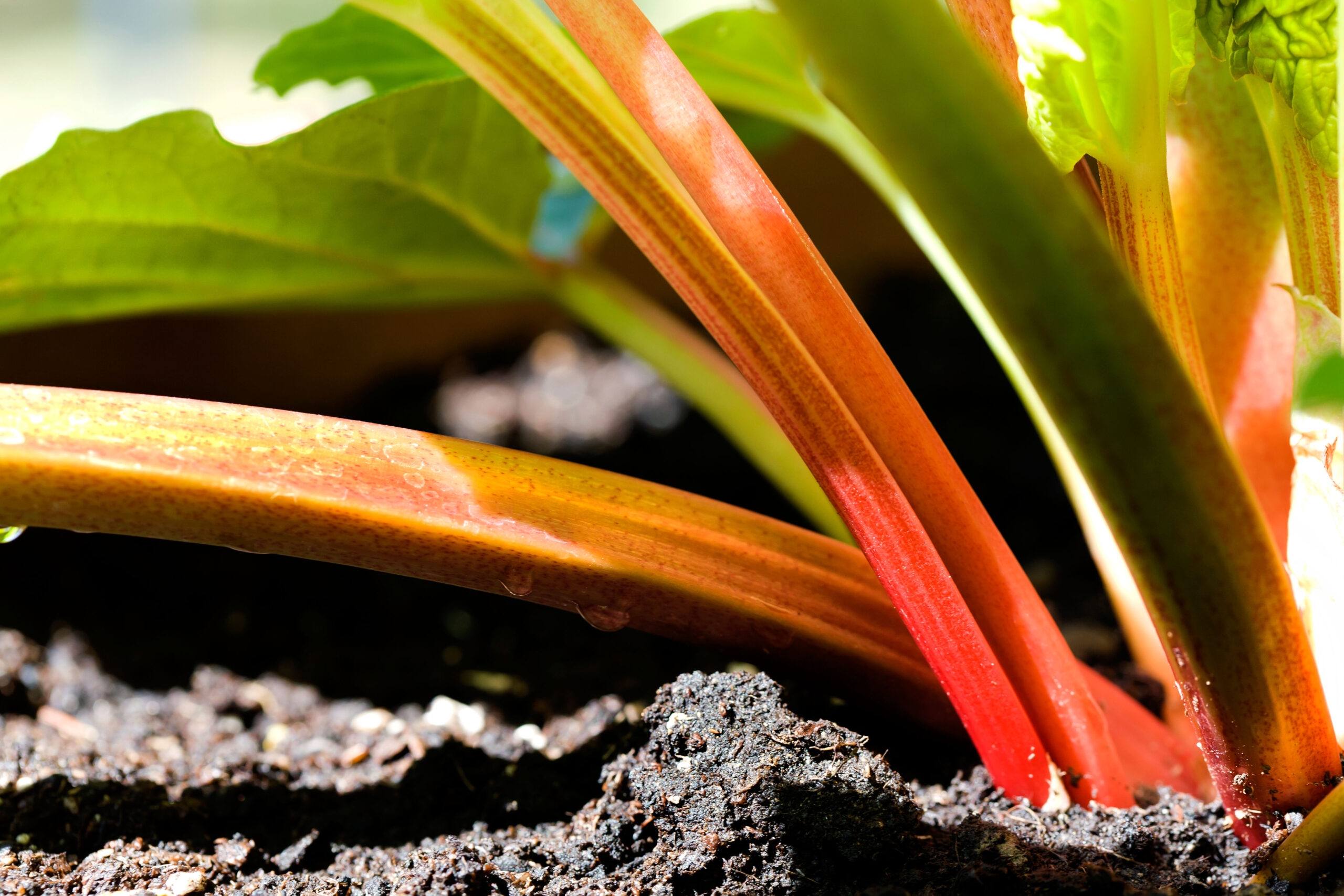
Rhubarb is easy to grow, too (Credit: Alamy)
Love The Garden then suggest the following:
- Clear the area of all weeds and stones.
- Plant the rhubarb crowns 1m (3ft) apart with 1.2m (4ft) between rows.
- Plant the crowns with their buds just below the surface of the soil.
You can read their full guide to growing rhubarb here.
How do you know if rhubarb is ready to pick?
If you’ve grown your own rhubarb, don’t think about picking it for the first year, as it’ll need to establish. After that, you’re good to go.
A few things to consider are:
- Don’t be fooled and simply opt for the brightest rhubarb crop, as colours can vary depending on the variety.
- Instead, you’ll need to look at the length of the stalks as an indicator for when to harvest (they typically grow between seven and 15 inches long when they’re freshest).
- When it’s ready to pick, the leaves of the rhubarb will also have fully opened, so use this as an indicator.

Look at that freshly picked rhubarb (Credit: Alamy)
It’s worth noting the age of your rhubarb before picking too much, too.
Savvy Gardening advises: “In their second year, harvest only up to 4 stalks per plant. In their third year and beyond, harvest as many stalks as you’d like, as long as the plant always has at least 6 stalks remaining to fuel continued plant growth.
“If you harvest too heavily, plant performance will be affected and subsequent stalks will not be as thick.”
Is rhubarb poisonous?
Rhubarb’s stalks are absolutely fine to eat (we’re sure you’ve gathered that by now.)
Saying that, the leaves of the vegetable are poisonous, and shouldn’t be eaten under any circumstances.
Heathline explain: “Rhubarb leaves contain high amounts of oxalic acid, which can cause health problems when eaten in higher amounts.
“Symptoms of toxicity include mild gastrointestinal symptoms, as well as more serious problems, such as kidney stones and kidney failure.”
Reports of humans being seriously ill as a result of eating rhubarb leaves are rare, but there really is no need to consume them, and we certainly wouldn’t advise taking the risk.
Stick to the stalks and we promise you’ll be more than satisfied.
READ MORE: Here’s everything we know about Blonde Chocolate
Is rhubarb good for you?
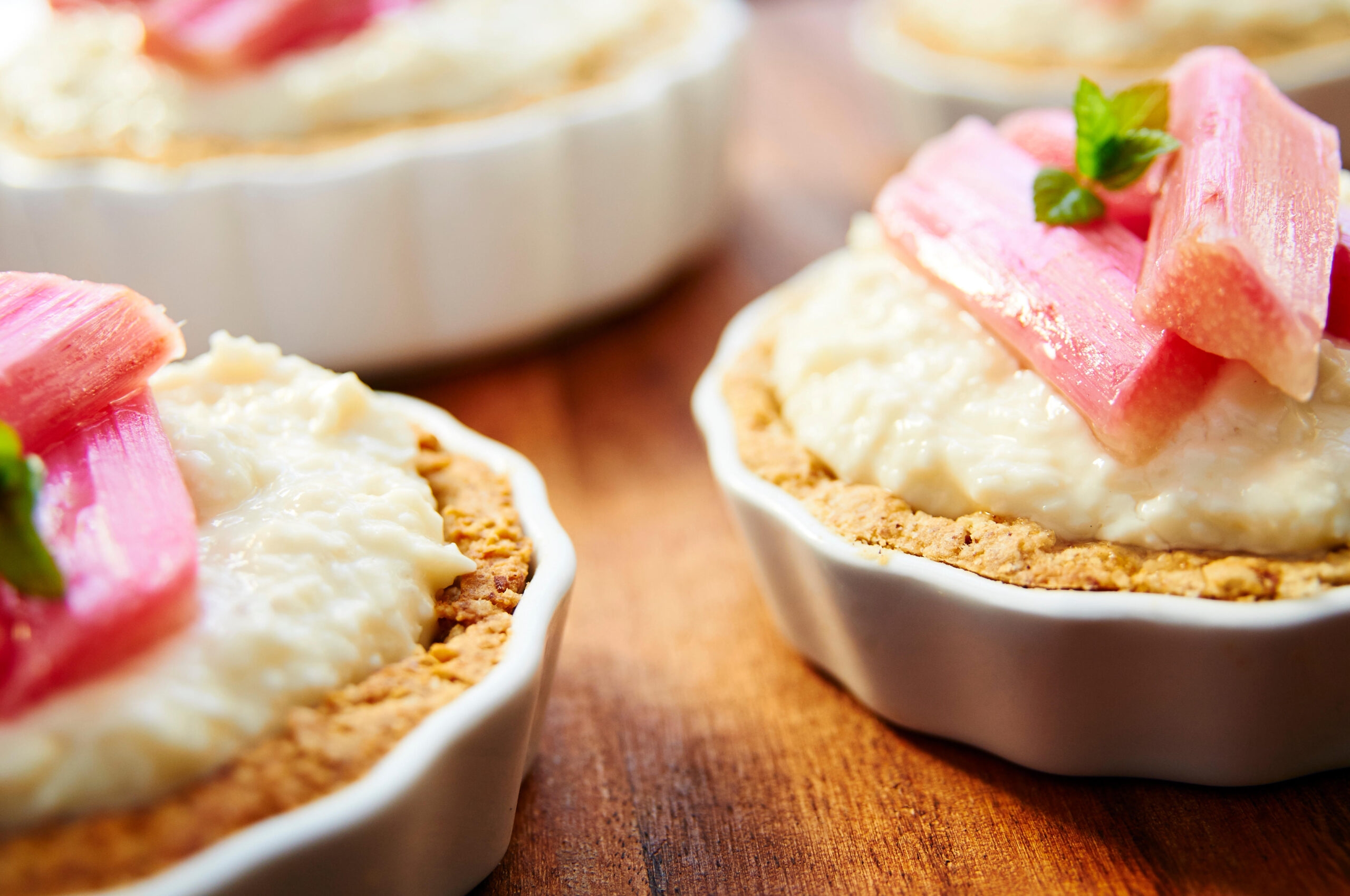
Rhubarb is über healthy, too (Credit: Alamy)
As we mentioned above, rhubarb has a load of health benefits – in fact, it was originally used in medicine thousands of years ago, before people begun to cook with it.
Web MD explains: “Rhubarb is rich in antioxidants, particularly anthocyanins (which give it its red color) and proanthocyanidins. These antioxidants have anti-bacterial, anti-inflammatory properties, which help protect you from many health-related issues such as heart disease, cancer, and diabetes.”
The vegetable is particularly high in vitamin K, which promotes bone health and healing. It’s also packed with vitamin A that helps skin health and prevents premature ageing.
The fibre in rhubarb can help to lower cholesterol and aid digestion, too, and it’s also rich with vitamin C which boosts immunity.
Given all this, it’s no wonder the plant was (and still is) hailed in Chinese medicine. They’re particularly fond of its digestive properties, and it was similarly regarded a medical wonder in the eyes of the Greeks and the Romans.
In fact, it was one of the most expensive medicinal plants in Europe in the 1500s, rivalling the likes of saffron.
Now it’s grown in abundance over here, we shouldn’t sleep it.
Rhubarb recipes
By now, we’re sure you’re aware just how much can be done with the humble rhubarb. It’s so much more than the ingredient in a sloppy school pudding or a boiled sweet.
If you’re looking for some further recipe inspo, then we’ve got you covered. Here are two very different things you can do with rhubarb, created by the team here at Twisted.
Strawberry and Rhubarb Galette
This Strawberry Rhubarb Galette is the perfect spring pud, with orange zest in the pastry and fresh, sweet strawberries which compliment the rhubarb beautifully.
Let your filling get all sugary and jammy in the oven and you’ve got a real showstopper of a dessert, here.
Rhubarb Gin Pitcher
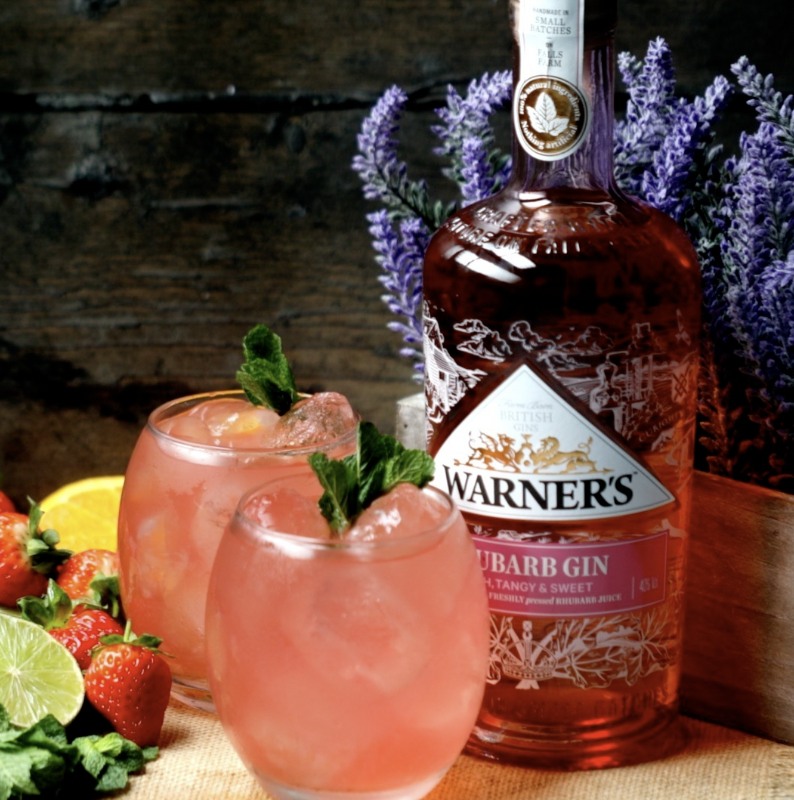
Rhubarb gin, anyone? (Credit: Twisted)
Rhubarb is also a cracking addition to gin. Don’t believe us? Try out this recipe for size.
We’ve used Warner’s rhubarb gin here, but you can use any variety you find on the shelves.
Also, feel free to make your own rhubarb gin if you really wanna push the boat out. To do this, you just marinade chopped rhubarb stalks and sugar in a jar of gin and leave it for three to five weeks, giving it a healthy shake daily until the sugar has dissolved.
Of course, the possibilities don’t end there. Have a play with some of the flavour combinations we’ve mentioned above and see what rhubarb wonders you can come up with this spring.



.jpg_dU0O4c?tr=w-2560,f-webp,q-70)